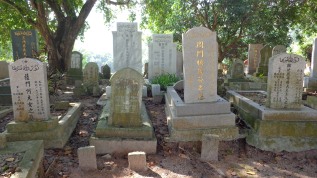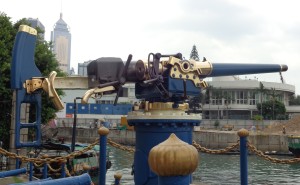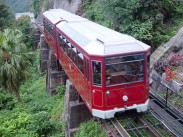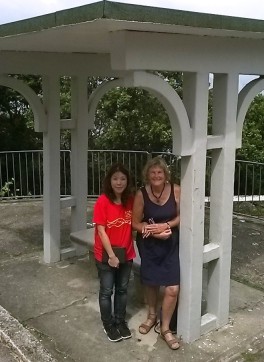
Magazine of the Royal Geographical Society (with IBG)
Rosemary Brown: freelance journalist, humanitarian worker and explorer
As told to Katie Burton; Published in I’m a Geographer 03 Jul 2020
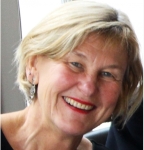 Rosemary Brown is a freelance journalist. In 2014, she followed in the footsteps of American journalist and adventurer Nellie Bly, who carried out a record-breaking 72-day trip around the world in 1889. A book about Rosemary’s trip is due out next year.
Rosemary Brown is a freelance journalist. In 2014, she followed in the footsteps of American journalist and adventurer Nellie Bly, who carried out a record-breaking 72-day trip around the world in 1889. A book about Rosemary’s trip is due out next year.
‘Last year, two of my lifelong dreams came true. One was to write a book, and the other was to get a Churchill Fellowship. The book is about my trip in the footsteps of Nellie Bly. I maybe didn’t do as much research in advance as I should have, but I’ve learned since that it’s better to get going than to get lost in the research. I did spend some time at the British Library, reading the microfiche newspaper accounts of her trip from the New York World newspaper. My eyes have never been the same.
I’ve always admired these Victorian explorers. I used to read about Gertrude Bell, Freya Stark, Isabella Bird, Mary Kingsley (they have her hat at the Royal Geographical Society). So they’d always intrigued me. My daughter was 19 at the time, and she won’t like me saying this, but I didn’t really approve of her role models. I just thought, look at what these amazing women were doing, when they couldn’t really do it. It was a man’s world then. Truly.
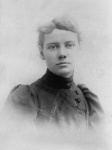
Nellie Bly redefined the role of women in journalism. In 1889, she set off on a 72-day trip around the world, which inspired Rosemary to trace the journey herself. She chronicles her experiences in her upcoming book.
And so I wanted to do something to put Nellie Bly on the map, and to put female explorers back on the map – the ones from the past and the ones now who just don’t get the same coverage. I thought, I’m not going to rant about it. I’m just going to try to do something.
These women just busted convention. Nellie Bly burst into an all-male newsroom, and she wasn’t welcome, but she excelled. And when she said, ‘I want to go around the world to see if I can go faster than Phileas Fogg’, [the protagonist of Jules Verne’s Around the World in Eighty Days] they said, ‘No we’re going to let a man go’. And she said, ‘Very well. You send a man. I’m going to the competing newspaper and let’s see who wins.’
So she and I clicked. She was an adventurer. She was a journalist. She pioneered investigative journalism. If she wanted to do it, she just did it. And this is what I think we aren’t doing so much anymore. We seem to be afraid to get out of our comfort zones.
The experience was really great. It’s not the way I like to travel. I don’t like to just go from one place to the other, so that part was quite frustrating. But I had to let Nellie take over. Don’t think I’m bananas, but there were a couple of times when I think she might have helped me. I got stuck in a typhoon in Hong Kong as I was trying to get into China – she went to Canton, which is now Guangzhou. So I thought, what would Nellie Bly do? I just walked down into the typhoon and believe it or not, the trains were running even though Hong Kong was shut down.
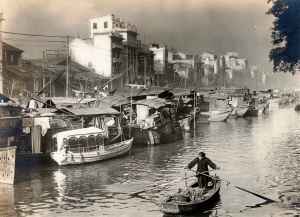
Canton, now known as Guangzhou, was one of the places that Nellie Bly visited during her 1889-90 expedition around the world – a trip that would inspire Rosemary Brown to write her upcoming book.
Photo: Royal Geographical Society Archives, Ato Photographic Association
People help you all along the way. And that’s one of the things I say – she believed in humanity. Her colleagues said, if you’re going on this trip, you’ve got to take a revolver. And she said, ‘I don’t believe I’m going to need one’. She didn’t take the camera either which was a drag – there are no pictures.
I thought once I got back and finished up the blog, that would be it. But oh no, Nellie Bly was not through with me. I’ve been able to do talks and we put together the Heritage of Women in Exploration conference – which I believe is the first conference like that ever held at the Royal Geographical Society. I’m also a founding trustee of the Women’s Adventure Expo – a hub for women adventurers. It’s really just about letting people know what women have done and what they’re doing now. If you do what you always do, you get what you always got, so it’s about just getting out there, seeing the horizon.
One of my favourite sayings is ‘leap and the net will arrive’. I’m not leaping so much anymore. But I think if you put yourself out there, things happen.’
CV
1954: Born in Toronto
1976–1983: Journalist for the Lakeland Ledger and the Tampa Tribune
1983: Journalism masters
1986–1989: Lived and worked with homeless women in Soho at the House of St Barnabas
2003–2017: Chair of the board at The Rights Practice
2004–2017: Communications manager at NGOs including The Rainforest Foundation
2013: Climbed Mount Kilimanjaro
2014: Nellie Bly trip
2019: Churchill Fellowship for work with refugees
2021: Release of Following Nellie Bly: Her Record-Breaking Race Around the World



